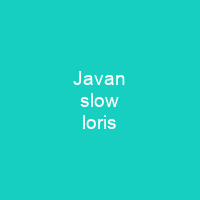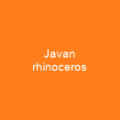The Javan Slow Loris: A Unique Primate of Java
Imagine a world where the night is filled with whispers, and among these are the soft rustles of the Javan slow loris (Nycticebus javanicus). This unique primate, native to the lush forests of Java, Indonesia, has captured our imaginations for centuries. But how much do we really know about this elusive creature?
Origins and Classification
The Javan slow loris was once considered a subspecies of the Sunda slow loris but was reclassified as a distinct species in 2000 based on its morphology and genetics. This decision highlights the complexity of primate classification, much like sorting out the tangled roots of an ancient tree.
Distinctive Features
The Javan slow loris is not just any primate; it has a distinctive white diamond pattern on its forehead, which makes it stand out in the dense foliage. Its face and back are marked with a distinct stripe that runs over the crown and forks, leading to the eyes and ears, creating a unique facial design. The color is yellowish-gray, while the head, neck, and shoulders have cream hues, making it a striking sight against the green backdrop of its habitat.
Size and Morphology
The Javan slow loris weighs between 565-687g (1.25 and 1.51 lb), which is larger than both the Sunda and Bornean slow lorises. Its body is adorned with morphometric parameters that set it apart, such as head length, muzzle length, and chest girth. The ornatus morphotype, distinguished by longer fur (26.8 mm) and lighter overall color compared to javanicus, adds another layer of complexity to its already unique appearance.
Behavioral Traits
Like a master climber, the Javan slow loris is nocturnal and arboreal, relying on vines for movement through the forest. Its diet includes fruit, tree gum, lizards, and eggs, making it a versatile predator in its environment. The similarity to lemurs noted by William Henry Flower in the 1860s suggests that this primate has a rich evolutionary history.
Habitat and Distribution
The Javan slow loris is found primarily in western and central Java, inhabiting both primary and secondary forests, bamboo forests, mangrove forests, and even chocolate plantations. This adaptability makes it a fascinating subject for conservationists but also poses challenges as its habitat faces increasing pressure from human activities.
Conservation Status
The Javan slow loris is critically endangered due to rapid population decline caused by poaching for the exotic pet trade and traditional medicine. With a low population density of 0.20-0.02 individuals per km², it faces significant threats. In Indonesia, it is used in traditional medicine and sold as an exotic pet, highlighting the complex interplay between culture and conservation.
Conservation Efforts
To combat these challenges, conservationists have implemented various strategies. Mid-air walkways built by conservationists help Javan slow lorises move between treetops, aiding local farmers in protecting their crops while ensuring the safety of the lorises. These efforts are crucial but face obstacles such as ineffective enforcement and uncertain numbers found in protected areas.
Despite these challenges, there is hope. Captive collections exist in Prague, Jakarta, Indonesia, and Singapore, providing a safe haven for those that cannot be released back into the wild. The Javan slow loris was included on ‘The World’s 25 Most Endangered Primates’ list and elevated to CITES Appendix I in 2007 for increased protection.
As we continue to learn more about this unique primate, it is clear that the Javan slow loris holds a special place in our hearts. Its survival depends on our collective efforts to protect its habitat and ensure its continued presence in the natural world. Can you imagine a future where these gentle creatures thrive once again? The answer lies in our hands.

You want to know more about Javan slow loris?
This page is based on the article Javan slow loris published in Wikipedia (retrieved on November 27, 2024) and was automatically summarized using artificial intelligence.







